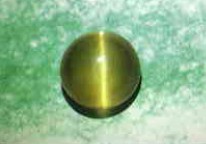CHRYSOBERYL - An Underrated Gem
One of the most underrated and little known gemstones is chrysoberyl.
Although it is rare, this stone
is very hard and durable and well suited to any jewelry use, including rings.
It has a hardness of 8.5 on the Mohs scale which goes from 1 to 10. The most common colors range
from honey yellow to yellow green, and the colors are quite intense. These can be very beautiful, but these gems are somewhat
rare and not often seen for sale in commercial jewelry stores. The prices
for these transparent gems are not
especially high as they are little known and demand is accordingly low. However, two other forms of chrysoberyl provide some of the most fascinating
and most valuable of all colored gemstones: Alexandrite and the
cats eye. Alexandrite is one of
the very few gems that actually
changes color from a green shade in daylight to red shade in incandescent light. Gems that change color
in different kinds of light are called photochroic.
The Chrysoberyl cat's-eye is by no means the only stone that shows a cats eye effect, however it has by far the most dramatic eye because of the dense, fine fibers that can occur in Chrysoberyl (it is these inclusions that form the "eye"). The line or "eye" effect in this gem can be very strong and it seems to float across the surface of the stone. It is similar to a star sapphire or star ruby, but with those gems, there are 3 lines that intersect, where in a cats eye, there is only one line. Translucent honey colored cats eye gems can be very striking and are also very valuable. The better the color and the stronger the eye effect, the more valuable the stone will be. The cats eye is probably the most commonly seen form of chrysoberyl, and high quality stones command a high price. The cats eye is commonly used in men's ring jewelry as it is a hard a durable stone that can stand up to some abuse. Good sized chrysoberyl cats eye gems of a carat or more can command prices of several thousand dollars per carat. Because of this, many times the forms of cats eye seen in commercial jewelry stores are not chrysoberyl, but lower cost simulants and synthetic stones. This is important to know when considering a purchase of this beautiful gem. Genuine chrysoberyl cats eyes come from several locations in Asia, as well as Sri Lanka (formerly Ceylon) and from the alluvial gravel deposits at Tunduru in Tanzania, East Africa.

Cats eye Chrysoberyl
ALEXANDRITE
Alexandrite has a distinguished and glamorous past: it was discovered in 1830 in Czarist Russia. Since the old Russian imperial colors are red and green it was named after Czar Alexander II on the occasion of his coming of age. Alexandrite can be found in jewels of the period as it was well loved by the Russian master jewelers. Master gemologist George Kunz of Tiffany was a fan of Alexandrite and the company produced many rings featuring fine Alexandrite in the late nineteenth and early twentieth century, including some set in platinum from the twenties. Some Victorian jewelry from England features sets of small alexandrites. Cats eye Alexandrites are extremely rare, and good quality color change stones command very high prices.
Alexandrite is also sometimes available as an unset stone but it is extremely rare in fine qualities. The original source in Russia's Ural Mountains has long since closed after producing for only a few decades and only a few stones can be found on the market today. Material with a certificate of Russian origin is still particularly valued by the trade. Some Alexandrite is found in Sri Lanka and Zimbabwe and Brazil but very little shows a dramatic color change. For many years, Alexandrite was almost impossible to find because there was so little available. Then in 1987, a new find of Alexandrite was made in Brazil at a locality called Hematita. The Hematita Alexandrite shows a striking and attractive color change from raspberry red to bluish green. Although Alexandrite remains extremely rare and expensive, the production of a limited amount of new material means a new generation of jewelers and collectors have been exposed to this beautiful gemstone, creating an upsurge in popularity and demand.
When evaluating Alexandrite, pay the most attention to the color change: the more dramatic and complete the shift from red to green, without the bleeding through of brown from one color to the next, the more rare and valuable the stone. The other important value factors are the attractiveness of the two colors - the more intense the better - the clarity, and the cutting quality. Because of the rarity of this gemstone, large sizes command very high premiums. Stones that show only a minor change in color may be called a color change Chrysoberyl, but these are not truly Alexandrite. Alexandrite is an expensive and rare gemstone. Prices of $2000 to $3000 per carat for stones less than a carat are not uncommon. As noted the price directly reflects the intensity of the color change and the desirability of the colors that are present.
